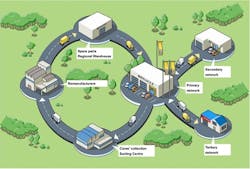Logistics Critical to Circular Economy Strategy
Nearly nine out of 10 (86%) of sustainability executives surveyed believe that circular economy will be important to their business two years from now, nearly double from two years ago when just 47% felt them important, according to findings of the 2016 UPS/GreenBiz Circular Economy Research Study released March 22.
The circular economy is defined as an alternative to a traditional linear economy (make-use-dispose) in which we keep resources in use for as long as possible, extract the maximum value from them while in use, then recover and regenerate products and materials at the end of each service life.
The online study, conducted by GreenBiz Group in partnership with UPS, captures the sentiments of sustainability executives and thought leaders to provide a deeper understanding of the business drivers and challenges associated with the circular economy.
The biggest growth in the adoption of the circular economy model will come from the technology sector, especially electronics such as computers and cell phones, as take-back systems and product reuse are most easily integrated in those models.
Awareness of the Circular Economy is Expanding
Nearly three in five respondents state that their organization is implementing circular economy principles in at least one of its product lines or service offerings.
“We are not surprised to see the growing importance of circular economy concepts to business,” said Ed Rogers, UPS senior director of global sustainability. “Our customers are recognizing the environmental and social impact of their products and operations across the entire value chain, from raw materials and design through manufacturing and logistics. They recognize the opportunity to move toward a model that keeps resources in use for as long as possible.”
Yet despite the prevalence of circular economy principles integrated into products and services, few companies stand out as leaders. Interface (21%) and Patagonia (16%) were the only two companies referenced with unaided recall when asked to identify companies that come to mind when thinking about circular economy.
Logistics plays a critical role in implementing a successful and sustainable circular strategy. Nearly unanimous, 97% of respondents claim logistics as either very important (87%) or somewhat important (10%) to transitioning to a circular economy.
Respondents stated that logistics companies can offer customers unique value by incentivizing greater participation in the circular economy through a seamless and convenient take-back model. Offerings such as pre-paid shipping labels, smart packaging and convenient take-back mechanisms help fuel market demand. Additionally, consumer and customer costs can be reduced through the use of backhauling as well as through load and route optimization.
“As this research shows, focusing on ‘first mile’ logistics is crucial to helping businesses implement a cost-effective circular economy,” said Rogers.
Need for Business Case is Both the Biggest Opportunity and Biggest Barrier
While there is great promise in the fundamental principles of a circular economy and keeping resources and materials in play endlessly, this alone won’t bring the circular economy to market or scale. The study suggests that for this concept to be embraced, businesses will need to address existing challenges and identify a better business case, and generate market demand through incentives focused on cost and convenience.
An insufficient business case was cited as the greatest barrier to implementing an effective, global circular economy. Other key barriers respondents identified include:
- Logistics costs to reclaim used goods (36%)
- Lack of executive leadership understanding/education (36%)
- Lack of consumer understanding/education (36%)
- Other business objectives taking priority (30%)
Creating market demand will be critical for widespread adoption of circular economy principles. Twenty-six percent of respondents identified customer and consumer demand for products that are recoverable, recyclable or refurbishable as the most important factor for adoption. The second most important factor is related to demand, as 18% of respondents cited the need for a market for reused products or recaptured materials and resources.
“Companies have many reasons to consider moving away from the traditional ‘make-use-dispose’ economic model to a circular one,” said John Davies, GreenBiz Group vice president and senior analyst. “In addition to growing demand among consumers who value sustainable businesses and products, businesses are also being motivated by factors such as resource scarcity and climate change. Our research shows that rethinking processes surrounding material inputs, product design and logistics will all be necessary to move toward a more regenerative, circular economy.”
Cost Savings and Convenience are Key Incentives
According to the study, both business customers and consumers are motivated by the same factors: cost savings and convenience. Respondents believe the best incentives to ensure the return and the reuse of consumer products or their components and materials at the end of its period of primary use include:
- Rebate in the form of cash back (56%)
- Convenience of returning a product at a brick-and-mortar location (47%)
- Ability to return a product using pre-paid shipping (42%)
- Discounts towards a future purchase (40%)
Respondents also stated that the best incentives to ensure the return and thereafter the reuse of industrial (B2B) products or their components and materials at the end of its period of primary use include:
- Producer or distributor physically reclaims product (59%)
- Turnkey packaging and pickup service (51%)
- Manufacturer refurbishes product and returns for continued use (48%)
- Discounts towards a future purchase (38%)
- Rebate in the form of cash back (34%)
